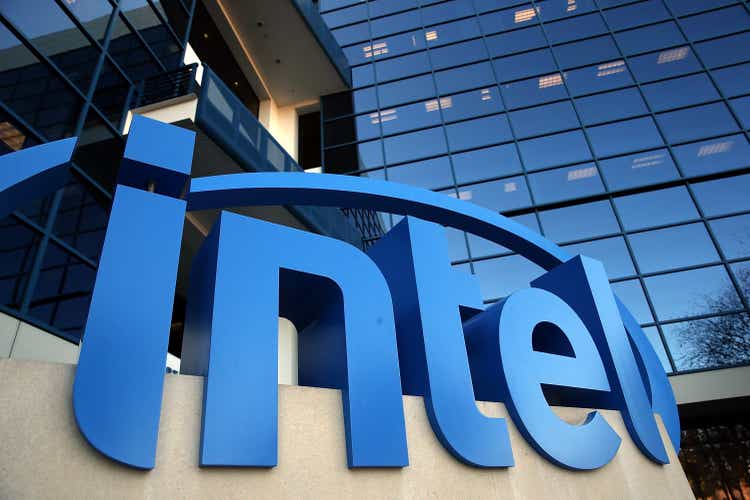Summary:
- After another dismal quarter, Intel shows once again they have not figured things out.
- Intel continues to lose market share to its competition.
- Is the dividend the next in line to be cut?
Justin Sullivan
I have been hearing it for over a year now, “how can you pass up on Intel, it is so cheap?” Sometimes stocks are cheap for a reason and Intel (NASDAQ:INTC) is cheap and will continue to get cheaper in my opinion.
A wise soul once said:
It is far better to buy a wonderful company at a fair price, than a fair company at a wonderful price
– Warren Buffett
Intel is nothing more than a fair company right now. They have proven nothing, and although I do not believe they are dead in the water, but right now, I am not sure how you could possibly look to buy shares of Intel.
If you are a long-term investor, and this might even be a stretch, but if you are willing to ride the coaster down with hopes of a turnaround, I can maybe see that, but I am in the camp that is waiting for them to prove it.
I actually was in the camp that thought 2023 could be the year we would eventually see some progress, but after the doozy of a report the company just released last week regarding their Q4 earnings and their 2023 guidance, I cannot touch this company.
At this point, many are likely beginning to question the leadership and direction, or lack thereof, of CEO Pat Gelsinger.
Let’s take a look at this dismal earnings report released by the company last week.
Dismal Q4 Earnings Report Showing No Progress
Senior analysts over at Bernstein described the earnings for Intel perfectly by calling it “something special.”
Here is a look at the company’s reported EPS and Revenues compared with analyst expectations for the quarter:
- Adj EPS: $0.10 vs $0.20 expected
- Revenue: $14.04 billion vs $14.45 billion expected
As you can see, the company missed on both the top and bottom line, both by a wide margin.
The company has run into a slew of headwinds that do not bode well for the company’s near-term performance. The PC market continues to remain weak, as years of demand were brought forward during the depths of COVID.
Revenues during the quarter were down 32% year over year, with gross margins down 14.5 points in terms of gross margin percentage, falling from 53.6% to 39.2%, which is difficult to put into words. The company is losing sales, and what they are selling, they are selling at way cheaper margins. Operating margin for the quarter was negative, falling 32 points to -8.1%.
However, that 39% is even higher than it looks because they made some accounting changes to how long they depreciate fixed assets. So on a more comparable basis, the gross margins would be more like 36%.
Here is a look at the company’s 3 largest segment results for Q4 2022:
- Computing: $6.6 billion, down 36% yoy
- Data Center: $4.3 billion, down 33% yoy
- Network and Edge: $2.1 billion, down 1%
AMD Outperforms Intel In A BIG Way…Again
Now let’s compare these results to Advanced Micro Devices (AMD) quarter who recently released their earnings as well.
- EPS: $0.69, adjusted vs $0.67 per share expected
- Revenue: $5.6 billion vs $5.5 billion expected
AMD beat on both the top and bottom lines. During the quarter, AMD saw revenues increase 16%, gross profits increase 18%, and gross margins rise 70 basis points to 51%. These are drastically different from what Intel’s abysmal quarter showed and further prove the company is in a whole heap of trouble.
Seeing sales, gross profits, and gross margins far surpass Intel has to be concerning for INTC shareholders, but one of the most concerning things was the performance in Data Centers.
The data center segment had been one of the few bright spots for Intel in a time when PC sales have slowed to a halt, something AMD confirmed as well. However, we saw Intel report Data Center revenues of $4.3 billion, which was a decrease of nearly 35%. AMD did not see the same slowing conditions within the data center segment, as they saw data center revenues climb 42% to $1.7 billion.
So why the major discrepancy between the two, you may ask? You cannot help but look at the progress AMD and Nvidia (NVDA) continue to make and take market share from Intel. AMD CEO Lisa Su noted that the inventory the company does have is primarily products for data centers and that she expects even stronger demand in the second half of 2023. In terms of taking market share, you can see the gains were very close between the two companies in terms of Intel down 35% and AMD data center revenue up 42%, making AMD the biggest beneficiary of Intel’s struggles.
Between the three, here is how they performed within the data center segment:
- Intel Data Center Sales: $4.3 billion, down 35%
- AMD Data Center Sales: $1.7 billion, up 42%
- Nvidia Data Center Sales: $3.8 billion, up 31% (Q3 numbers)
So you can see between the three, Nvidia using Q3 earnings makes up nearly $40 billion of the data center chip space on an annual basis.
I believe this is something that is going to continue to be the case, not only with AMD, but with other competitors as well.
Weak Guidance Compounds A Weak Quarter
Given the rough start and uncertainty ahead, Intel is unable to even issue full year 2023 guidance. Instead, the company chose to only guide through Q1, which they are roughly one-third of the way through.
Here is a look at the Q1 2023 Guidance:
- $11 billion in Q1 sales
- ($0.15) adjusted EPS
- Gross Margins of 34.1%
Those are brutal across the board. The $11 billion in sales, assuming they can actually hit that, would mark a 40% year-over-year decline. Before we touch on EPS, let’s first look at the gross margin story. As we saw up above, in Q4 2022, the company maintained gross margins above 50%, and this quarter they dropped to 39%. Q1 ’23 we are expected to see another 500 basis points of decline in terms of margins.
Now for EPS, which was certainly a major disappointment. To put this into perspective, a year ago, the company reported Q1 ’22 adjusted EPS of $1.13. This coming quarter, Intel is saying they will see negative profits, which is something they have only done once over the course of multiple decades.
PC sales are expected to remain weak and this has caused the company’s inventory glut to remain large, one reason we are seeing lower margins as the company looks to unload much of this inventory off their balance sheet at cheaper prices.
AMD also showed guidance confirming a slowdown in Q1 2023, but they are looking for only a 10% decline rather than the 40% decline Intel is looking for.
Is A Dividend Cut Imminent?
Intel currently pays an annual dividend of $1.46 per share, which equates to a dividend yield of 5.2%. Based on the 2022 EPS, the dividend payout ratio currently sits near 80%, which is obviously way too high for a non-REIT dividend stock.
Intel reported adjusted free cash flow of negative $4.1 billion, meaning they are borrowing to pay their dividend. On the year, Intel paid $6.0 billion in dividend payments, so with a negative free cash flow yield, the dividend has come into focus as a potential place for the company to cut and save on cash, especially if the business operations continue to erode.
This is not something that will happen in the quarter ahead, but if things are not turning around by Q2 or Q3 of this year, I would not be surprised to hear Intel is cutting their dividend.
Investor Takeaway
If there is anything to be excited about right now for Intel shareholders, it is the fact that the dividend has not YET been cut. The company pays a nice dividend, which is really just being used to offset the losses investors are piling up in the stock. However, as we just looked at, the dividend could eventually be cut in the second half of the year if things do not turn around.
There are not many out there that can say they are up in the stock as INTC shares have fallen nearly 45% in the past 5 years, and are up only 30% the past decade. For comparable purposes, the S&P 500 (SPY) is up roughly 170% the past 10 years.
Pat Gelsinger is continuing to look for ways to cut cost in a period in which he continues the turnaround story, which includes himself taking a pay cut. The turnaround story needs to speed up, but if this can play out, it could be the momentum Intel needs to return to its rightful place within the space.
AMD and NVDA continue to eat Intel’s lunch and until things turn around for multiple quarters, this stock merely looks like a falling knife. I will be taking a wait-and-see approach.
Would love to hear your comments on Intel down below.
Disclosure: I/we have no stock, option or similar derivative position in any of the companies mentioned, and no plans to initiate any such positions within the next 72 hours. I wrote this article myself, and it expresses my own opinions. I am not receiving compensation for it (other than from Seeking Alpha). I have no business relationship with any company whose stock is mentioned in this article.
Additional disclosure: Disclaimer: This article is intended to provide information to interested parties. I have no knowledge of your individual goals as an investor, and I ask that you complete your own due diligence before purchasing any stocks mentioned or recommended.

